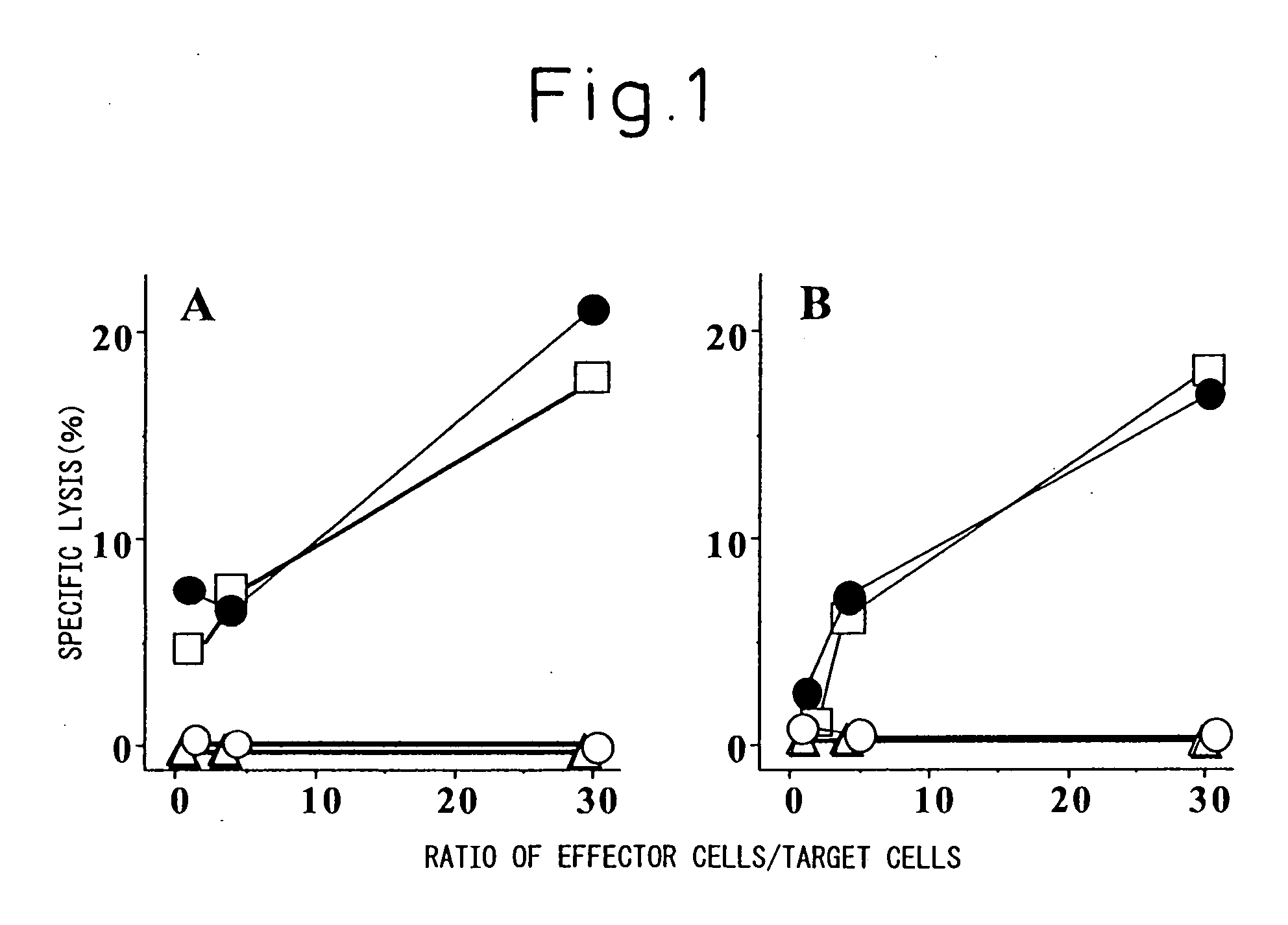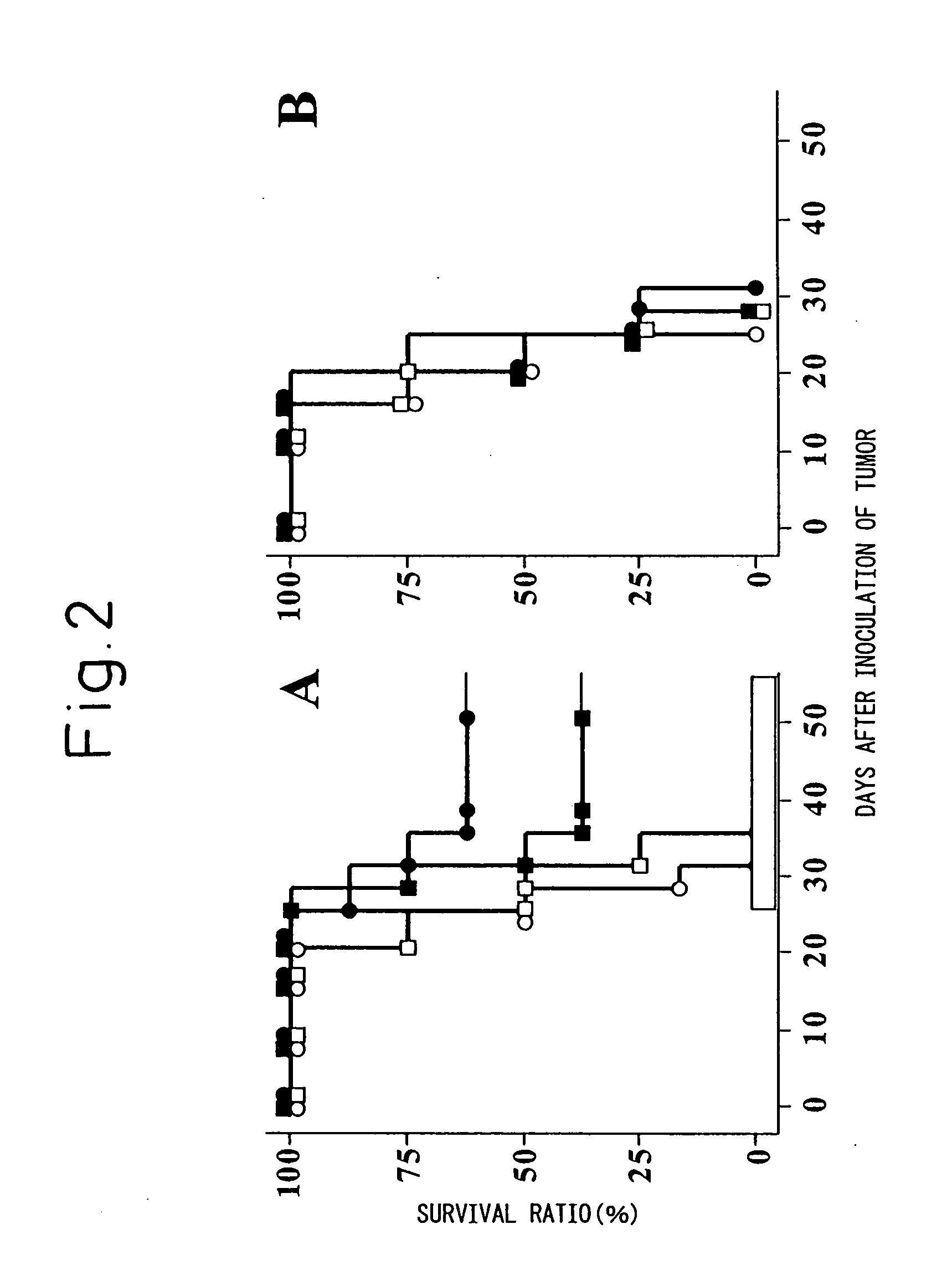Cancer vaccine containing cancer antigen based on tumor suppressor gene wt1 product and cationic liposomes
a cancer antigen and tumor suppressor technology, applied in the direction of tumor rejection antigen precursors, antibody medical ingredients, peptide sources, etc., can solve the problems of histocompatibility complex, inability to effectively deliver peptides, and inability to administer such peptides as cancer vaccines
- Summary
- Abstract
- Description
- Claims
- Application Information
AI Technical Summary
Benefits of technology
Problems solved by technology
Method used
Image
Examples
example 1
Preparation of Lipopolysaccharide-Blast (LPS-blast)
[0029] From C57BL / 6 mice, spleen cells were recovered, and the cells were incubated for 3 days in a complete RPMI medium containing lipopolysaccharide (LPS) (10 μg / ml). After washing, the cells were incubated in a complete RPMI medium containing the cancer antigen peptide Db 126 (1 μM) and ovalbumin (OVA) (100 μg / ml). After washing, the cells were suspended in 2 ml Hanks, balanced salt solution (HBSS) which was set as the lipopolysaccharide-blast (LPS-blast).
Evaluation of the Ability of Inducing Cytotoxic T Cells (CTL)
[0030] C57BL / 6 mice were immunized three times weekly by subcutaneous administration, to the back thereof, of a mixture of the cancer antigen peptide Db 126 and lipofectin (LPF) (mixed at a 1:2 weight ratio of Db 126 and LPF), and as a positive control by the intraperitoneal administration of lipopolysaccharide-blast (LPS-blast) (1 ml / mouse). Ten days after the final immunization, spleen cells were recovered and s...
example 2
Cancer Antigen-Specific Anti-Tumor Effect when Lipofectin (LPF) was Used as the Cancer Vaccine Carrier
[0033] Since Example 1 has shown that cytotoxic T cells are effectively induced by using lipofectin (LPF) as an adjuvant for the cancer antigen peptide Db 126, cancer antigen-specific anti-tumor effect when immunized using lipofectin as an adjuvant (carrier) was examined for the purpose of further confirming the usefulness of lipofectin (LPF) as an adjuvant for cancer vaccines.
[0034] As the tumor model, WT1 gene-introduced C1498 cells (C1498muWT1 cells) were used; as the immunization animal, C57BL / 6 mice were used; and as the model cancer antigen, the peptide Db 126 was used. Thus, C57BL / 6 mice were immunized three times weekly by subcutaneous administration, to the back thereof, of the same mixture as in Example 1 of the cancer antigen peptide Db 126 and lipofectin (LPF) (10 nmol / mouse), or by the intraperitoneal administration of lipopolysaccharide-blast (LPS-blast) (1 ml), and...
PUM
| Property | Measurement | Unit |
|---|---|---|
| size | aaaaa | aaaaa |
| width | aaaaa | aaaaa |
| affinity | aaaaa | aaaaa |
Abstract
Description
Claims
Application Information
 Login to View More
Login to View More - R&D
- Intellectual Property
- Life Sciences
- Materials
- Tech Scout
- Unparalleled Data Quality
- Higher Quality Content
- 60% Fewer Hallucinations
Browse by: Latest US Patents, China's latest patents, Technical Efficacy Thesaurus, Application Domain, Technology Topic, Popular Technical Reports.
© 2025 PatSnap. All rights reserved.Legal|Privacy policy|Modern Slavery Act Transparency Statement|Sitemap|About US| Contact US: help@patsnap.com



